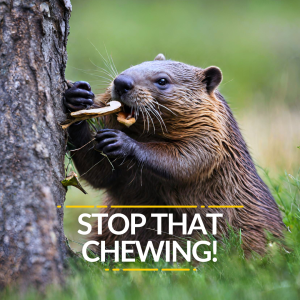Stop That Chewing!
January 25, 2024

Published January 25, 2024
Beavers. A species that humans are simultaneously fascinated and frustrated with. They are the largest rodents in North America and Eurasia and the second largest rodents worldwide. Beavers are what biologists call a “keystone species” due to their ability to shape freshwater habitats, which benefits many other animal and plant species. What are beavers most famous for? Chewing! Their teeth are as strong as metal, and they never stop growing. With self-sharpening teeth, they gnaw logs and branches and use the material to build their homes, creating wetlands in the process.
Not everyone sees beavers as being beneficial. They can be seen as nuisance pests and destructive animals, especially when beaver dams add to flooding in developed areas. Scientists are reintroducing beavers in certain places on the West Coast to help mitigate drought and wildfires. But on the East Coast, where beavers have thrived for decades, it’s more about coexistence.

When beaver activity results in property damage or concerns about public health and safety, steps can be taken to alleviate the problem in a non-lethal manner. One experimental method is painting trees with an exterior latex paint/mason sand mixture. The painted trees establish a “no-bite zone” for the beavers, causing them to look for building materials (and food) in different areas. Conservation Agent Julia Flanary has researched this relatively new method and decided to employ this technique in the Town of Maynard with the help of one of the high school students she mentors. She presented the methods and results of her study at the SuAsCo Climate Resiliency Coalition meeting in November 2023.
An area across from the Ben Smith dam was chosen to facilitate this beaver mitigation project, as it is a shallow area that consistently fills in with sediment. When trees fall, it creates a hazard. This was a perfect place to determine whether this mitigation technique would help stop hazardous tree falls from beaver activity.
After a couple of months of observation, to determine which species and sizes of tree beavers are targeting, Julia and her student focused on protecting birch and maple trees over 6 inches in diameter. They then painted tree trunks with a mixture of brown latex paint and sand approximately 3 feet up the tree (the height of a beaver mouth when they stand on their hind legs to chew). Only trees that had their bark intact were painted. The research on this project suggests that when beavers lick/bite the sand mixture, it tricks their brains into believing it is a rock, or they just don’t like the taste.
Every beaver family has different tastes, so 100% effectiveness was not achieved when using this method. The beavers in their area, who typically go for birch, hadn’t touched those painted for the study. So far, the project has been successful, as they haven’t seen a lot of beaver activity. However, continued observation over a few years will be needed to predict results reliably.
Many other methods can be used to mitigate beaver activity, such as metal fencing around trees or trapping badgers for relocations. However, installed fencing would need constant monitoring and can damage trees. Beavers are also hard to relocate as they get highly stressed, usually resulting in euthanasia. In comparison, Julia’s method is low-cost and relatively non-invasive.
Fun Facts
Beavers have several key adaptations that help them work underwater. A transparent membrane drops over their eyes, and a valve in each ear closes to keep water out. They have a second pair of lips that they close behind their teeth, allowing them to chew or carry wood underwater without drowning. They can also hold their breath for up to 15 minutes underwater. Their teeth are as strong as metal, and they never stop growing!
Through this project, Julia has been able to do a lot of outreach to the public on beavers and their role in the ecosystem.
If you would like to learn more about this project, please contact Julia Flanary, jflanary@townofmaynard.net.

